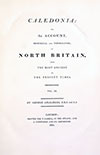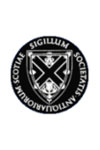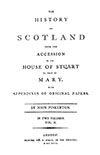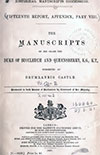

Durnock was a tower extant in the 16th century but nothing of it now remains and its exact location is unclear.
On the historical main route from Gretna to Annan the village of Dornock stands on rising ground to the north of the Dornock Burn, which flows down through marshy land to the Solway Firth. There was an old harbour on the coast not far from the village and fisheries which were historically considered important. Close by the Battle of Dornock was fought between English invaders under William of Lochmaben, Sir Ralph Dacre and Sir Anthony Lucy and a much smaller Scottish force under Sir William Douglas, Lord of Liddesdale in March 1333.
The village’s church is built just to the north of the site of the pre-Reformation St. Marjory’s church, the patronage of which was held by the Earls of Douglas by the early 15th century. In 1411 Simon of Carruthers received the church’s patronage and a grant of the “lands of Middilby and Dronnok” from Archibald Douglas, Earl of Douglas.
James II granted to John Carruthers of Mouswald, possibly Simon’s nephew, “the lands of Mousfald, Loganetenement, Medilby, Dronnok, Ellirbek, Hatilland Hill, Cummertries, Hoddome, Tunnergath, Hallthis, Cumlungand, Hultvhate, Stanrase and Wamfray” in 1452.
Following the Scottish defeat at the Battle of Flodden in 1513 English raiding parties entered the south of Scotland and laid waste to the countryside. Lord Dacre reported one such incursion in May 1514:
And upon the West Marchies of Scotland, I haif burnt and distroyed the townshipps of Annand, Dronok, Dronokwod, Tordoff, Fyshegewghe, Stokes, Estrige, Ryelande, Blawetwood, Foulsyke, Westhill, Berghe, Rigge, Stapilton, Wodhall, Raynpatrike, Woddishill, Overbrotts, Nethirbrotts, Elistrige, Caluertsholme, Beltemmount, Hole, Kirkpatrike, Hyrdhill, Mossesyde, Stakehughe, Bromeholme, Walghopp, Walghopdale, Baggraye, Murtholme, Langhane, Grymesley, and the Watter of Esk, fro Stabulgorton downe to Cannonby, beyng vi myle in lienth. Where as there was, in all tymes passed, ccccth pleughes, and above; whiche er now clerely waisted, and noo man duelling in any of them, at this daye; saue oonly in the Towrys of Annand, Stephill, and Walghopp.The History of Scotland, Volume II
John Pinkerton, London, 1797
In 1516 James V confirmed the “seven merk lands of Dronok” to Simon Carruthers and his wife, Katherine Carlile, and the lands subsequently passed through her to the Carlyles of Torthorwald. In 1529 Michael Carlile, the brother and heir of the late James, Lord Carlile, was granted a charter which included “the lands and mill of Durnock, with the advowson of the church of Durnock”.
The lands of Dronok seem to have later returned to the Carruthers family as they were owned by Simon Carruthers of Mouswald when he married Agnes, daughter of Cuthbert Murray of Cockpool, in 1538. Durnock was burned once again in 1543, by Thomas, Lord Wharton, the victor at the Battle of Solway Moss the previous year:
Also we brent Tordof, Dronoke, Blayt, Blaytwod, West hilles, Staillis, Stokes and others howses and steydes, beuildinges, and that litle corn they had was brent at all thes towns aforesaid.The Hamilton Papers, Volume II
Joseph Bain, Edinburgh, 1890
Carruthers died in 1548 and was succeeded by his daughters Janet and Marion between who his lands were divided. Janet Carruthers seems to have granted her part of the lands of Dronok to Sir James Douglas of Drumlanrig in 1562, while in 1564 Marion appears to have sold her part to Charles Murray of Cockpool.
Douglas had plenty of other properties and it may be that Durnock fell out of use at this time, perhaps having been damaged beyond repair during English attacks, although this is speculation on my part. The tower of Dundronok is marked on Lord Burghley’s map of 1590 but with few clues as to its specific location beyond its relative proximity to Torduff Castle.
Douglas transferred the lands to his son, also James, along with barony of Mouswald in 1608. In the 1640s the lands were in the possession of Archibald Douglas of Dornock and by 1681 were owned by William Douglas, 1st Duke of Queensberry, who was described variously as the “laird of Dornock” and “Lord Douglas of Kinmont, Middlebie and Dornock”.
The tower of Durnock is marked on Blaeu’s map of 1654 to the west of the Dornock Burn and north-east of Durnock Kirk.

Joan Blaeu, Amsterdam, 1654map image courtesy of NLS
Around 1700 a new house, Dornock House, was built in the classical style on the south edge of the village. In 1718 James Douglas of Dornock bought lands from Sarah Irving and William Knox that her uncle, William Irving of Kirkconnel, had owned.
Dornock House was occupied in 1768 by John Douglas of Dornock. James Douglas of Dornock married his cousin, Philadelphia, only daughter of Sir John Johnstone of Westerhall, in the mid-18th century. The Douglas Dukes of Queensberry, and later the Douglas Scott Dukes of Buccleuch are said to have held Dornock into the 19th century although I haven’t been able to find a definitive reference to this.
Dornock House was later extended as part of a complex of farm buildings, and the location of the tower has been lost. Historic Environment Scotland propose a site to the south of and overlooked by the village, although this doesn’t appear to be based on anything other than the aforementioned 16th and 17th century map references. The Ordnance Survey map of Annan and Dornock, published in 1899, shows a well to the south of the church partly enclosed by a bend in the Dornock Burn although I haven’t been able to ascertain the age of the well.
The lower-lying site to the south of the village may not seem so likely a castle site today, however if the Dornock Burn was navigable at that time then it may make more sense. The higher ground now occupied by Dornock House, close to the site of the medieval church, may however be a more likely location, with remnants of the tower perhaps even being incorporated into Dornock House or neighbouring farm buildings.

Alternative names for Durnock
Dornock; Dornock House; Dronnok; Dronok; Dronoke; Drounok; Drunnok; Dundronok; Durno; Durnok



















